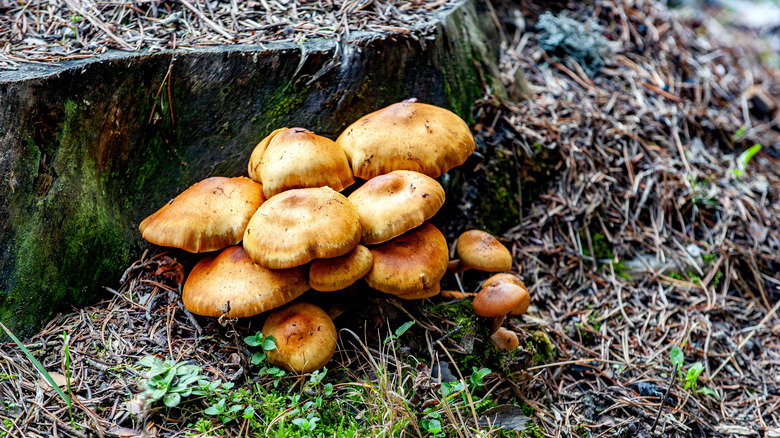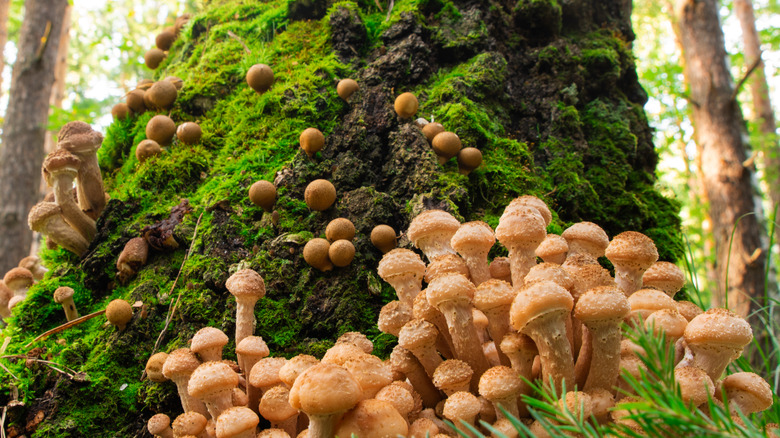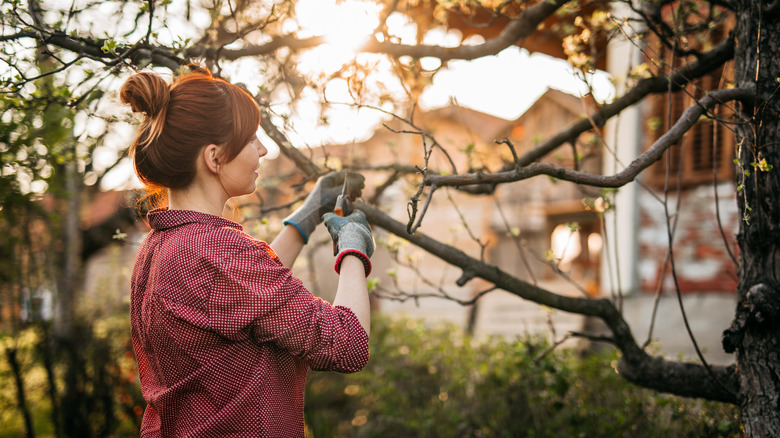What To Do If Your Plants Are Infected With Honey Fungus
Honey fungus may sound like quite an oxymoron, but unfortunately, there's nothing sweet about it should it appear on your plants. Scientifically known as Armillaria, this parasitic fungus is known to attack woody plants and trees with destructive tendencies. It feeds off of the roots of its host plant until it dies, threatening the biodiversity in your backyard. Several distinctive features can help you identify this parasite. You'll notice creamy white, mushroom-like clusters near the base of infected plants. These mushroom clusters will eventually develop a honey color with pale gills on their underside. Additionally, this fungus produces thick, black rhizomorphs or roots, a key sign that your plant may be infected. Unfortunately, there is no cure for honey fungus, and any infected plants will need to be removed.
If you suspect a plant or tree on your property may be infected with honey fungus, there are a few symptoms that can help you confirm your suspicions. Many plants will experience a dieback of branches, wilting foliage, and a decline in overall health, as well as the characteristic mushrooms around its base. If the roots of the plant are visible, you may also observe white fungal growth and decay or rot. Should honey fungus appear on one of your trees or plants, it's important to act swiftly and remove the infected plant to prevent this parasite from spreading through nearby soil to other unaffected host plants, ravaging any vulnerable neighbors.
How to remove honey fungus
Since no cure for honey fungus exists, you should act swiftly. Any infected plants or trees must be removed to prevent the proliferation of this parasite in your soil. As soon as you confirm this infection, it's important to remove and destroy any infected plant materials, including roots, stems, and foliage. This process will help eliminate the host of the fungus and will reduce the risk of further infection in your yard.
To get started, dig around the base of the affected plant or tree and remove as much of the root system as possible, as this is the primary site of infection for honey fungus. You can cut through the roots using a sharp tool or saw to prevent the spread of the fungus to nearby plants. Remove as much of the woody plant as physically possible to protect other nearby plants and trees in your yard. Once you've dug it up, you'll need to dispose of it properly. One effective method is to burn all of the plant materials to destroy the fungus spores and avoid further contamination of your soil. If burning isn't allowed in your town, you can also bag up the materials and bring them to a designated waste disposal site to be safely processed. It's imperative that you do not compost diseased plant materials as they will infect your entire compost and, eventually, the rest of your garden or property as you fertilize with this resource.
Care practices to prevent honey fungus
While discovering honey fungus on any plants and trees in your yard will require you to excavate and dispose of them quickly, you can develop healthy gardening practices to help deter this parasitic fungus from wreaking havoc in your yard. Raising healthy plants is the first step. Healthy plants are more resistant to diseases and parasites, so it's important to be sure you're providing adequate water, nutrients, and sunlight to keep your plants happy throughout the growing season. Additionally, be sure to prune your plants regularly and remove any dead or diseased materials. Another great gardening practice is to be sure you have excellent soil drainage. Wet or poorly draining soils create great homes for fungus to thrive. Moreover, incorporating organic matter into your soil, like compost, for example, can help improve the structure and drainage while feeding your plants, all while deterring fungal infections.
When choosing plants and trees for your yard, it's not a bad idea to look into fungal-resistant species or varieties to help give your plants a leg up on any risk of infection. Though no plants are completely immune, some species have a greater tolerance or higher resistance to this fungus and have a better chance of survival. Once planted, be sure to provide favorable conditions for your plant or tree to survive by not crowding your plants. Evenly spacing your vegetation allows for better airflow and reduced humidity, discouraging fungal growth in the end.


